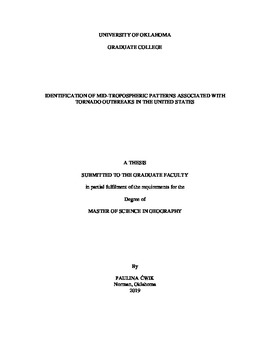| dc.description.abstract | The identification of large-scale atmospheric patterns associated with tornado outbreaks poses a great challenge. It involves analysis of physical processes occurring at different time and space scales that, in the right configuration, result in environmental conditions favoring tornado outbreak formation. Over the years, there have been numerous studies that utilize the notion of ‘tornado outbreaks.’ The term has been used to define severe weather events where the occurrence of multiple tornados has been determined. The exact meaning of ‘tornado outbreak,’ however, has been repeatedly redefined and has evolved throughout the years. Depending on the availability of scientific data, technological advancements, and the purpose of these definitions, different authors offered diverse approaches to shape the perception and applications of ‘tornado outbreak.’ This work provides an extensive review of the evolving nature of the ‘tornado outbreak’ definition. Each decade contains multiple examples of manuscripts that contributed to either changes in the tornado outbreak definition or its perception.
This work also offers a statistical approach that can be used to define tornado outbreak events and identify historic cases from the tornado report database of the National Weather Service’s Storm Prediction Center. The approach was informed by the review of tornado outbreak definitions and used kernel density estimation to identify 4,991 outbreaks from 1950 to 2017 –– an average of 73 outbreaks per year. Applying a data-driven threshold of seven or more tornados in a cluster, 333 major tornado outbreaks were found to occur east of the Rocky Mountains throughout the 68 years of the analysis. The highest count of tornado outbreaks by month was found in May.
Finally, to support efforts directed towards research on large-scale atmospheric patterns and subseasonal forecasting of tornado outbreaks, this study applies principal component analysis (PCA), hierarchical clustering, and silhouette analysis to identify synoptic-scale patterns of 500-hPa geopotential height associated with tornado outbreaks in the United States. The PCA was performed on a similarity matrix derived from monthly 500-hPa geopotential height anomalies from the 20th Century Reanalysis during times when tornado outbreaks initiated. The analysis was performed using T-mode decomposition for observations during May from 1950 to 2014. To determine the number of PC patterns to retain, congruence coefficient analysis on loadings from Promax and Varimax transformations was performed. The PC analysis identified two major atmospheric patterns for the month of May. To validate these results, two additional statistical methods were used: hierarchical clustering and silhouette analysis. Both methods identified the same patterns as the PC analysis, and thus validated our results. | en_US |
